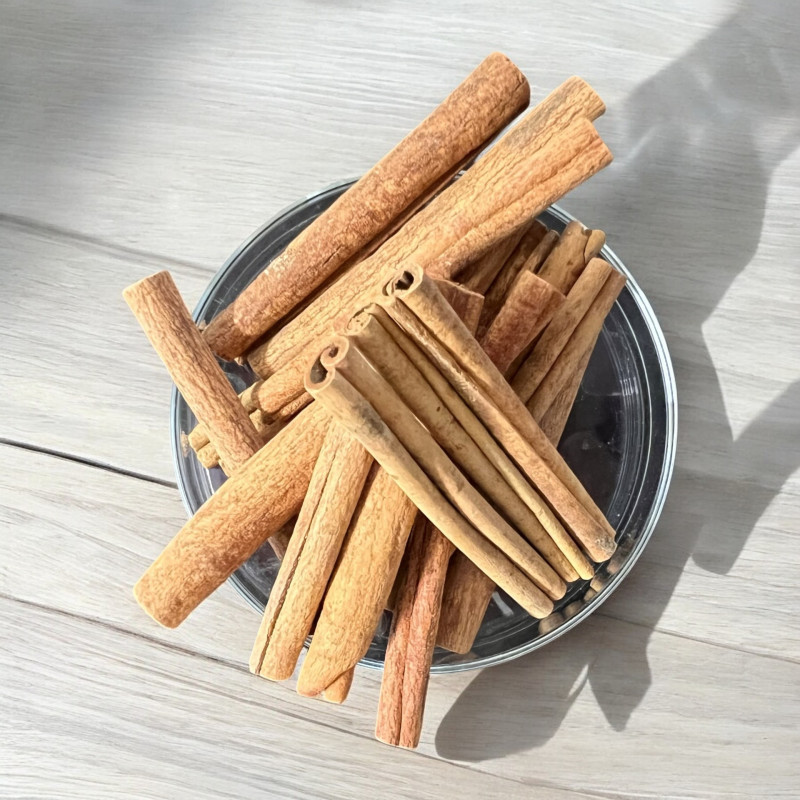
Reference: 3N7137901


Its flavor is mild, warm, and almost sweet.
You can use it to add a delightful aroma to your jams, tea, coffee, mulled wine, and spirits.
 Delivery
Delivery
Mondial Relay
 Returns
Returns
See conditions
 Payments
Payments
100% secure
Livré en sachet refermable
Uses in Cooking and Beyond:
These cinnamon sticks measure between 6 and 7 cm.
Their flavor is mild, warm, and sweet, with a delightful aroma! When whole, like these sticks, cinnamon is best reserved for infusions (spirits, jams, tea, or coffee), as it's quite difficult to grind into fine powder with typical household tools—this variety of cinnamon is particularly tough.
In cooking, it's often paired with apples, apricots, and fruits in general, as well as compotes and jams, chocolate, liqueurs, and spirits (mulled wine, hypocras, punch, spiced rum). You can also mix it with other spices and tea (preferably black) to create a delicious homemade "chai tea." However, for chai, I prefer Ceylon cinnamon, which is more friable and easier to break into pieces.
Cinnamon is also used in Oriental tagines and many Indian dishes. It's an essential ingredient in the "five-spice" blend (Asian cuisine) and "four-spice" (for flavoring stuffings and pâtés) and is key in spice blends for gingerbread.
These cinnamon sticks are also perfect for decorative purposes, where they hold up better than their more delicate Ceylon counterpart: use them for Christmas tree decorations in small bundles, decorative collages, potpourri, or even as knife rests at the table (again, in small bundles). A refined touch—these 7 cm sticks can also be offered to guests as stirrers for their coffee, subtly infusing the drink with cinnamon!
Some studies suggest that cinnamon has interesting medicinal properties as well.
Who am I ?
Origin: Indonesia
Scientific name: Cinnamomum burmanii or Cinnamomum cassia
This variety of cinnamon is more commonly known as "cassia." The tree is now cultivated in warm regions around the world. The flavor of cinnamon comes from the aromatic oil contained in the tree’s bark.
Cinnamon is the inner bark of the cinnamon tree, a species in the Lauraceae family (the same family as bay laurel). In my opinion, Indonesian cinnamon is not the best in terms of flavor, and I prefer Ceylon cinnamon. However, Indonesian cinnamon is the most widely used, as it's often cheaper and, being very hard, it won’t crumble into dishes, which can be an advantage. It’s also important to note that the quality of cinnamon isn't determined by its length (it’s always cut into sections of varying sizes), but by the appearance of its cross-section. Ceylon cinnamon is layered and friable, like a cigar, while Indonesian cinnamon is thick and hard.
The part of the tree used to make cinnamon sticks is the thin inner layer of bark, and the scraping and rolling processes are all done by hand! This gives an idea of the effort involved in producing each cinnamon stick.
A Little History:
The Chinese have been harvesting cinnamon since ancient times. It was known in antiquity and used by the Egyptians in the embalming process. Cinnamon only arrived in France around 1220 and can be found in the famous medieval drink "hypocras."
Data sheet
Reference: 3N7137901
Reference: 00033929-0001
Reference: punch
Reference: 2M6273801
Reference: verveine
Reference: cardamomeverteE
Reference: 050721
Reference: 108017302
Reference: camomilleRom
Reference: SPW06600
Reference: badianeE
Reference: 6470
Reference: 00033929-0001
Reference: bergamote
Reference: 26545D
Reference: ecorcecitronH
Reference: 7N7525705
Reference: 6N7456401

Its flavor is mild, warm, and almost sweet.
You can use it to add a delightful aroma to your jams, tea, coffee, mulled wine, and spirits.